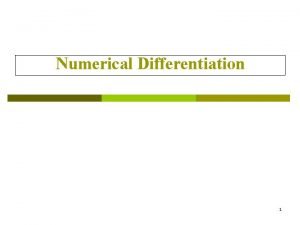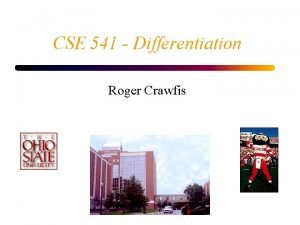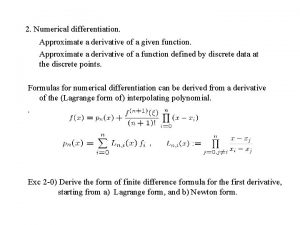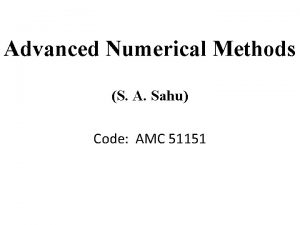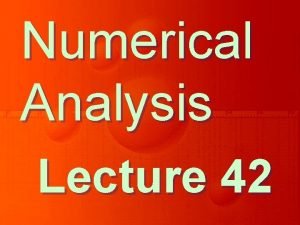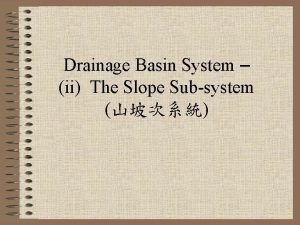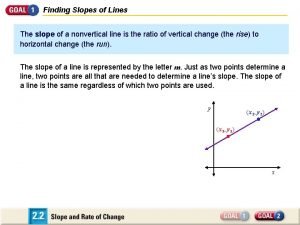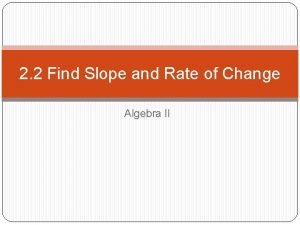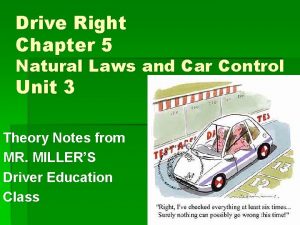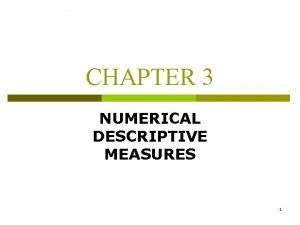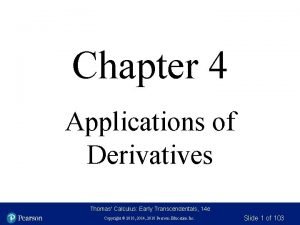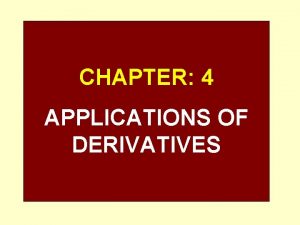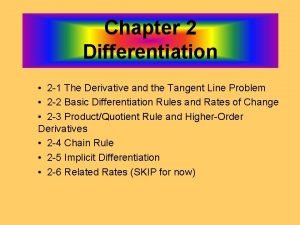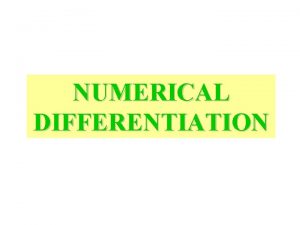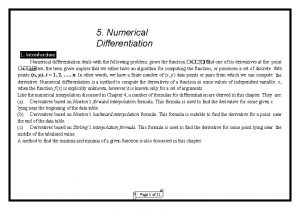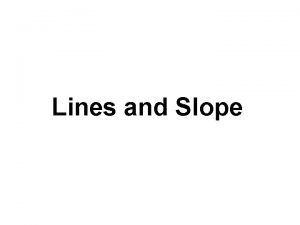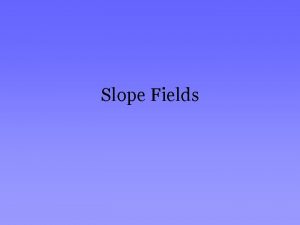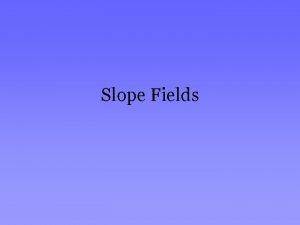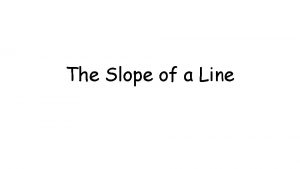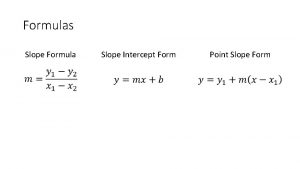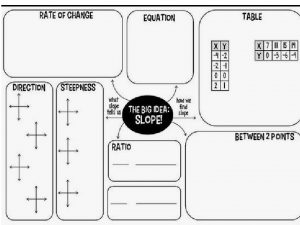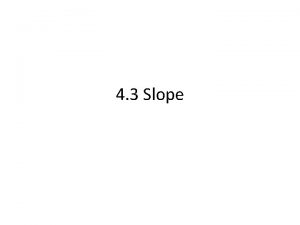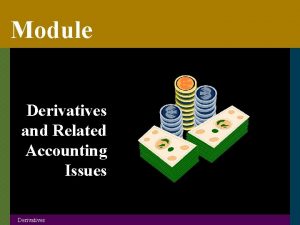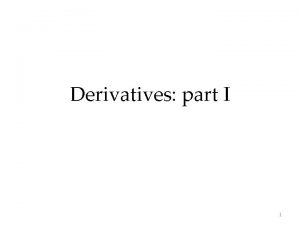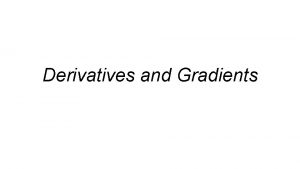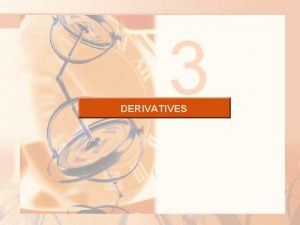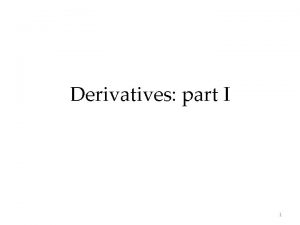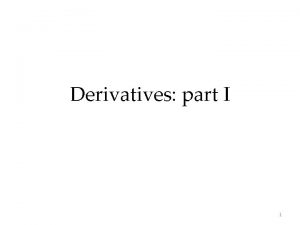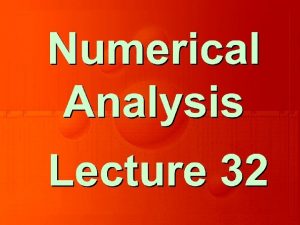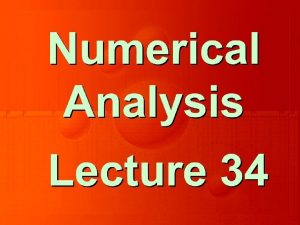Chapter 19 Numerical Differentiation Estimate the derivatives slope





























- Slides: 29

Chapter 19 Numerical Differentiation § Estimate the derivatives (slope, curvature, etc. ) of a function by using the function values at only a set of discrete points § Ordinary differential equation (ODE) § Partial differential equation (PDE) § Represent the function by Taylor polynomials or Lagrange interpolation § Evaluate the derivatives of the interpolation polynomial at selected (unevenly distributed) nodal points


Evenly distributed points along the x-axis xi-3 xi-2 xi-1 xi xi+1 xi+2 xi+3 Distance between two neighboring points is the same, i. e. h. Unevenly distributed points along the x-axis x 1 x 2 x 3

Numerical Differentiation Forward difference Backward difference Centered difference

Forward difference ue r T i r e d iv t a v e on i t a m i x Appro h xi 1 xi xi+1 x

Backward difference e A pp ro xi m at io n ue r T i r e d iv t a v h xi 1 xi xi+1 x

Centered difference ue r T i r e d iv t a v e n o i t a m i x o r p p A 2 h xi 1 xi xi+1 x

y First Derivatives i-2 i-1 § Forward difference § Backward difference § Central difference i i+1 i+2 x

Truncation Errors § Uniform grid spacing

Example: First Derivatives § Use forward and backward difference approximations to estimate the first derivative of at x = 0. 5 with h = 0. 5 and 0. 25 (exact sol. = -0. 9125) § Forward Difference § Backward Difference

Example: First Derivative § Use central difference approximation to estimate the first derivative of at x = 0. 5 with h = 0. 5 and 0. 25 (exact sol. = -0. 9125) § Central Difference

Second-Derivatives § Taylor-series expansion § Uniform grid spacing § Second-order accurate O(h 2)

Centered Finite-Divided Differences

Forward Finite-divided differences

Backward finite-divided differences

First Derivatives Parabolic curve i-2 i-1 i § 3 -point Forward difference § 3 -point Backward difference i+1 i+2

Example: First Derivatives § Use forward and backward difference approximations of O(h 2) to estimate the first derivative of at x = 0. 5 with h = 0. 25 (exact sol. = -0. 9125) § Forward Difference § Backward Difference

Higher Derivatives § All second-order accurate O(h 2) § More nodal points are needed for higher derivatives § Higher order formula may be derived

19. 3 Richardson Extrapolation D is the true value but unknown and D(h 1) is an approximation based on the step size h 1. Reducing the step size to half, h 2 =h 1/2, we obtained another approximation D(h 2). By properly combining the two approximations, D(h 1) & D(h 2), the error is reduced to O(h 4).

Example of using Richardson Extrapolation Central Difference Scheme By combining the two approximations, D(h/2) & D(h), the error of f’(h) is reduced to O(h 4).

Ex 19. 2: Richardson Extrapolation § Use central difference approximation to estimate the first derivative of at x = 0. 5 with h = 0. 5 and 0. 25 (exact sol. = -0. 9125)

General Three-Point Formula Ø Lagrange interpolation polynomial for unequally spaced data

Lagrange Interpolation § 1 st-order Lagrange polynomial § Second-order Lagrange polynomial

Lagrange Interpolation § Third-order Lagrange polynomial

Lagrange Interpolation L 2(x)f(x 2) L 0(x)f(x 0) x 0 L 1(x)f(x 1) x 1 x 2

General Three-Point Formula Ø Lagrange interpolation polynomial for unequally spaced data Ø First derivative

Second Derivative § First Derivative for unequally spaced data § Second Derivative for unequally spaced data

Differentiation of Noisy Data

MATLAB’s Methods § Derivatives are sensitive to the noise § Use least square fit before taking derivatives § p = polyfit(x, y, n) - coefficients of Pn(x) § polyfit(p, x) - evaluation of Pn(x) § polyder(p) - differentiation
 Numerical integration c++
Numerical integration c++ 1st order derivative formula
1st order derivative formula Numerical differentiation
Numerical differentiation Numerical differentiation
Numerical differentiation Stirling's formula for numerical differentiation
Stirling's formula for numerical differentiation Numerical differentiation examples
Numerical differentiation examples What is slope decline
What is slope decline Converting point slope to slope intercept
Converting point slope to slope intercept Slopes of lines
Slopes of lines Slope review classifying slope
Slope review classifying slope Estimate the stopping distance chapter 9
Estimate the stopping distance chapter 9 Numerical descriptive statistics
Numerical descriptive statistics Chapter 4 applications of derivatives
Chapter 4 applications of derivatives Chapter 4 applications of derivatives
Chapter 4 applications of derivatives Chapter 2 differentiation
Chapter 2 differentiation Hình ảnh bộ gõ cơ thể búng tay
Hình ảnh bộ gõ cơ thể búng tay Frameset trong html5
Frameset trong html5 Bổ thể
Bổ thể Tỉ lệ cơ thể trẻ em
Tỉ lệ cơ thể trẻ em Gấu đi như thế nào
Gấu đi như thế nào Tư thế worms-breton
Tư thế worms-breton Alleluia hat len nguoi oi
Alleluia hat len nguoi oi Các môn thể thao bắt đầu bằng tiếng bóng
Các môn thể thao bắt đầu bằng tiếng bóng Thế nào là hệ số cao nhất
Thế nào là hệ số cao nhất Các châu lục và đại dương trên thế giới
Các châu lục và đại dương trên thế giới Công thức tính độ biến thiên đông lượng
Công thức tính độ biến thiên đông lượng Trời xanh đây là của chúng ta thể thơ
Trời xanh đây là của chúng ta thể thơ Cách giải mật thư tọa độ
Cách giải mật thư tọa độ 101012 bằng
101012 bằng Phản ứng thế ankan
Phản ứng thế ankan

